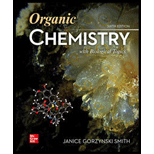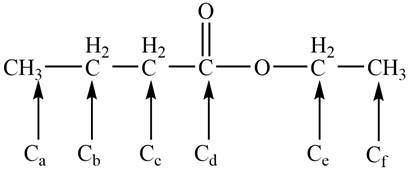
Concept explainers
(a) How many
signals does each of the following compounds exhibit?

(a)
Interpretation: The number of
Concept introduction: The number of NMR signal in a compound is equal to the number of chemically non-equivalent protons present in that compound. In
Answer to Problem 36P
The given compound A gives four signals and compound B gives five signals in
Explanation of Solution
The given compound A is the ball and stick model of

Figure 1
There are four non-equivalent protons
The given compound B is the ball and stick model of propyl butyrate. The bond-line representation of the compound B with all chemically non-equivalent protons is shown below.

Figure 2
There are five non-equivalent protons
The given compound A gives four signals and compound B gives five signals in
(b)
Interpretation: The number of
Concept introduction: The number of NMR signal in a compound is equal to the number of carbon atoms present in that compound. In
Answer to Problem 36P
The given compound A gives five signals and compound B gives six signals in
Explanation of Solution
The given compound A is the ball and stick model of

Figure 3
There are five non-equivalent carbon atoms
The given compound B is the ball and stick model of propyl butyrate. The bond-line representation of the compound B with all chemically non-equivalent carbon atoms is shown below.

Figure 4
There are six non-equivalent carbon atoms
The given compound A gives five signals and compound B gives six signals in
Want to see more full solutions like this?
Chapter 12C Solutions
ORGANIC CHEMISTRY W/BIOLOGICAL TOPICS
Additional Science Textbook Solutions
Chemistry & Chemical Reactivity
Organic Chemistry (8th Edition)
Chemistry: The Central Science (13th Edition)
The Organic Chem Lab Survival Manual: A Student's Guide to Techniques
Chemistry: An Introduction to General, Organic, and Biological Chemistry (13th Edition)
- A compound with a molecular formula C12H24 exhibits an H+ NMR spectrum with only one signal and a 13 C NMR spectrum with two signals. Draw the structure of the compound.arrow_forwardm a le How many ¹H NMR signals are expected for this compound? How many 13C NMR signals are expected for this compoundarrow_forward(a) How many 1H NMR signals does each compound show? (b) Into how many peaks is each signal split?arrow_forward
- How many H-NMR signals would you expect to see for this compound?arrow_forwardHow many 1H NMR signals would you expect for each compound?arrow_forwardRank the signals found within the 13C NMR spectrum for the following compound from 1 (most upfield; lowest chemical shift) to 3 (most downfield; highest chemical shift). Carbon a b C Chemical Shift (Choose one) (Choose one) (Choose one) X Sarrow_forward
- Determining the Number of Peaks in an NMR Signal How many peaks are present in the NMR signal of the labeled protons of each compound?arrow_forwardPlease determine the number of H-NMR spectrum signals. Thank youarrow_forwarda.) Annotate the 1H - NMR spectrum by labeling each signal (A-Z) and assigning them to the correct hydrogens on the structure of your unknown molecule Annotate the 13C- NMR spectrum by labeling each signal (A-Z) and then assign the A-Z labels to the correct carbons on the structure of your unknown molecule.arrow_forward
 Organic Chemistry: A Guided InquiryChemistryISBN:9780618974122Author:Andrei StraumanisPublisher:Cengage Learning
Organic Chemistry: A Guided InquiryChemistryISBN:9780618974122Author:Andrei StraumanisPublisher:Cengage Learning
